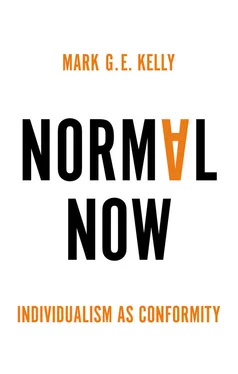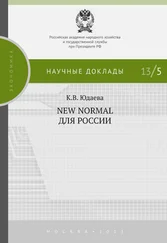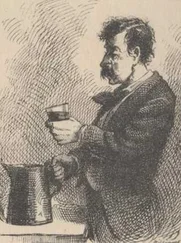Foucault finds that, in the Middle Ages, there was initially only one systematic method for dealing with contagious disease, namely that used to deal with leprosy: to remove the visibly sick from society in order to prevent the spread of disease. 10This approach did not work with the Black Death pandemic that descended on Europe in the fourteenth century, however, because that new disease was so contagious that people spread it before they could be exiled. So a practice was adopted of continuously monitoring habitations once plague had appeared in a vicinity, looking for signs of infection and isolating any household in which it appeared. Though this was not exactly the twenty-first-century lockdown with contact tracing with which we are now so familiar, it nonetheless represents the same basic approach. This in effect requires norms – that is, specific ideas about exactly what a healthy person should be like in order to detect relatively small variations from these. This is still the basic approach we have taken today with COVID, where a cough or elevated temperature raises an alarm. Hence I do not see in our response to the contemporary pandemic a new normal strictly speaking, so much as an instantiation of an old one, albeit in an age of hand sanitizer and phone apps.
In contrast to age-old measures to control the spread of disease, normality has, in other areas, developed into something rather more sophisticated. A crucial development in this regard was certainly the explicit formulation of the concept of the norm as such. This occurred by the seventeenth century at the latest, with that notion and the derived one of normality expanding in influence rapidly throughout the nineteenth century. What is crucial to grasp about the novelty of this notion is its original reference to an ideal model for the operation of a particular thing. Previously, there were perhaps some templates for making certain things, and plenty of rules – but nothing was governed by a positive model of perfection towards which a thing was pushed without ever entirely reaching it. With the introduction of the norm, however, increasingly many things began to be normalized , brought into a relation with a governing norm to which they were now made to tend.
This pervasive normalization began relatively modestly. French normative grammar was invented to provide a model to which people might conform in their writing, whereas earlier grammars had merely listed rules. Industrial and military norms followed as standardized production and regimented warfare developed in Europe, in answer to a prior situation in which incompatible components and motley troops were inhibiting the aims of industrialists and generals. The adoption of a normative model of the functioning of the human organism, not merely for triaging plague-afflicted habitations but for general use, in turn produced modern medicine as we know it, providing a clear standard to diagnose illness relative to the obscure conceptions of disease that had previously circulated. While we might certainly want to criticize all these developments – the suppression of natural change and diversity in language by normative grammar, the familiar woes of an industrialized society, the increase in deaths from warfare in the mechanical age and the mistreatment of many individual cases by a one-size-fits-all scientific medicine – we may nonetheless see this initial adoption of the concept of normality as clearly furthering the goals of the fields in which it made its mark.
After this point, certainly from the nineteenth century – and, I believe, accelerating more or less continuously thereafter – the phenomenon of the norm metastasized throughout society, a spread emblematized and perhaps even caused by the popularization of the notion of the ‘normal’ itself. Above all, two institutions are implicated in this spread of the norm. 11The first is surely modern medicine: hospitals, and then the emergence of general practice medicine, spread medical ideas throughout society, dynamized in the twentieth century by the introduction of mass health insurance schemes (both public and private). Almost every individual in industrialized societies is now medically supervised – on an ever more continuous basis – from birth. Medical discourses and terms are increasingly absorbed and repeated by patients, used by them autonomously to describe themselves, and people start to self-diagnose based on medical principles without the direct intervention of the medical institution. A further, powerful mutation occurred via the development of a branch of medicine, psychiatry, concerned not with the body as such but with the mind.
The diffusion of norms involved a raft of other institutions, of course, and moreover much of this diffusion presumably occurred outside formal institutional settings. A crucial development, alluded to above, which occurred in medicine, but quickly spread across other institutions and then outside them, was the appearance of norms for human behaviour. Medicine’s original norms applied to the organic condition of bodies, and norms had appeared governing the motions of bodies in particular situations (such as in military firing lines or on industrial production lines), but behaviour came to be medicalized and normalized as such with the invention of the medical discipline of psychiatry (which is approximately as old as modern medicine itself), and the later academic discourse of psychology (from the end of the nineteenth century). Psychology and psychiatry explicitly pertain to the human ‘psyche’, which is to say to our minds (or indeed our souls, to translate this Greek word a different way). 12However, psychologists and psychiatrists cannot peer directly into our consciousnesses, even today. Rather, they must primarily be concerned to monitor our visible behaviour, whether or not they proclaim an explicitly ‘behaviourist’ orientation. All the new social institutions that emerged and became pervasive from the eighteenth century to the twentieth – principally the school, the hospital, the prison, the factory and, most obviously, the insane asylum – are shot through with this psychological normalization of behaviour.
Mass public education, appearing in earnest in the late nineteenth century, has been the other key institution for the diffusion of norms, besides medicine. For the first time, all children were required to attend schools. This new omni-education was intensely normalizing from its inception. Its teachers were trained in institutions then called ‘normal schools’, the chief function of which was explicitly to impart norms. The most obvious norms operative in schools are those of educational attainment, but mass education has also always been prominently concerned with inculcating more general norms of behaviour. These include the simple but highly transferable classroom norms of obedience and attentiveness, but also encompass a more general concern with the moral education of pupils: schools deliberately and loudly proclaim their mission to impart a broad spectrum of attitudinal and behavioural norms that are supposed to stand students in good stead in later life. Relatedly, the school is a major venue for the transmission of medical norms: morality and public health have always been normatively linked. This once meant that children’s juvenile sexuality would be shaped and constricted; today, this approach has given way to an attempt positively to produce healthy sexual practices, as well as to inculcate acceptance of others’ sexualities, but the basic principle remains the same, namely producing what is deemed hygienic and ethical adult behaviour.
I imagine the reader might well ask, in relation to these claims of mine about norms, whether things weren’t always like this: weren’t there always such models? To this, I would suggest that we imagine this to be the case precisely because we are today so dominated by norms that it no longer seems conceivable that things could ever have been otherwise, or ever could be again. Although it does not affect the specific claims I will go on to make in this book, the critical force of my argument does depend to an extent on norms being an invention and hence being something that might reasonably be expected to disappear.
Читать дальше












